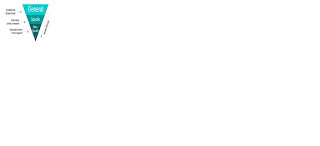Introduction
In your introduction, you need to let the readers and markers of your report know why the report is important and what exactly the report is about. It is essential to establish these things because it places the reader/marker in a better position to understand the significance of the material presented in the rest of the report (Hay, 1996). Although the introduction comes at the beginning of the report, it is not the first section you should write. It is easier to write the introduction after you have dealt with your method and results section because that way you are introducing the section with knowledge about what you did and what the results were. This knowledge allows you to shape your introduction so it leads up to your findings more specifically.
In your introduction, you need to answer questions such as
What do you hope to learn from the research?
What question is being asked?
Why is this research important?
(adapted from Hay, 1996).
This diagram provides an outline of the sequence of information that needs to be presented in the introduction.

The introduction starts generally, introducing the broad context within which your research fits. You need to provide a review of the literature that impacts on your research area. The literature needs to provide the reader/marker of your report with:
an understanding of the conceptual and theoretical background, context and justification for the research you are undertaking;
an appreciation of the significance of this area and in particular your topic; for example,
why does this question need researching and
how does it contribute to, fit in with, or differ from other available work on this subject (Hay, 1996)?
With your literature review should follow the pattern depicted in the diagram; for example, it should review studies to establish the general area, then move towards studies that more specifically define or are more specifically related to the research you are conducting. It is important to note that your literature review MUST NOT be a series of quotations strung together; instead it needs to provide a critical analysis of previous work (Hay, 1996). Your literature review uses both the past tense and the present tense; for example,
PAST tense: Gilles (1999) examined the effect of…, The model predicted that …..
PRESENT tense: A dormant seed bank is a solution for these populations to survive.
The past tense is used to refer to a particular experiment and the specific results of a particular experiment that has been carried out in the past. The present tense is used to refer to information that is not confined to a particular experiment.
The introduction ends with a statement of your specific hypothesis or hypotheses. This statement of the hypothesis should logically follow on from your literature review and you may want to make an explicit link between the variables you are manipulating or measuring in your study and previous research (O’Shea, 1996). The present tense is used to state your hypotheses; for example,
It is predicted that… ,
It is hypothesised that …
There is no need to write the title Introduction before this section: its position at the start of the report identifies it as an introduction (Findlay, 1993). Some departments or tutors may require you to include the aims or objectives of your study in a separate section after the Introduction so you should check this with your lecturer or tutor.
by: Team Uni Learning
http://unilearning.uow.edu.au/

No comments:
Post a Comment